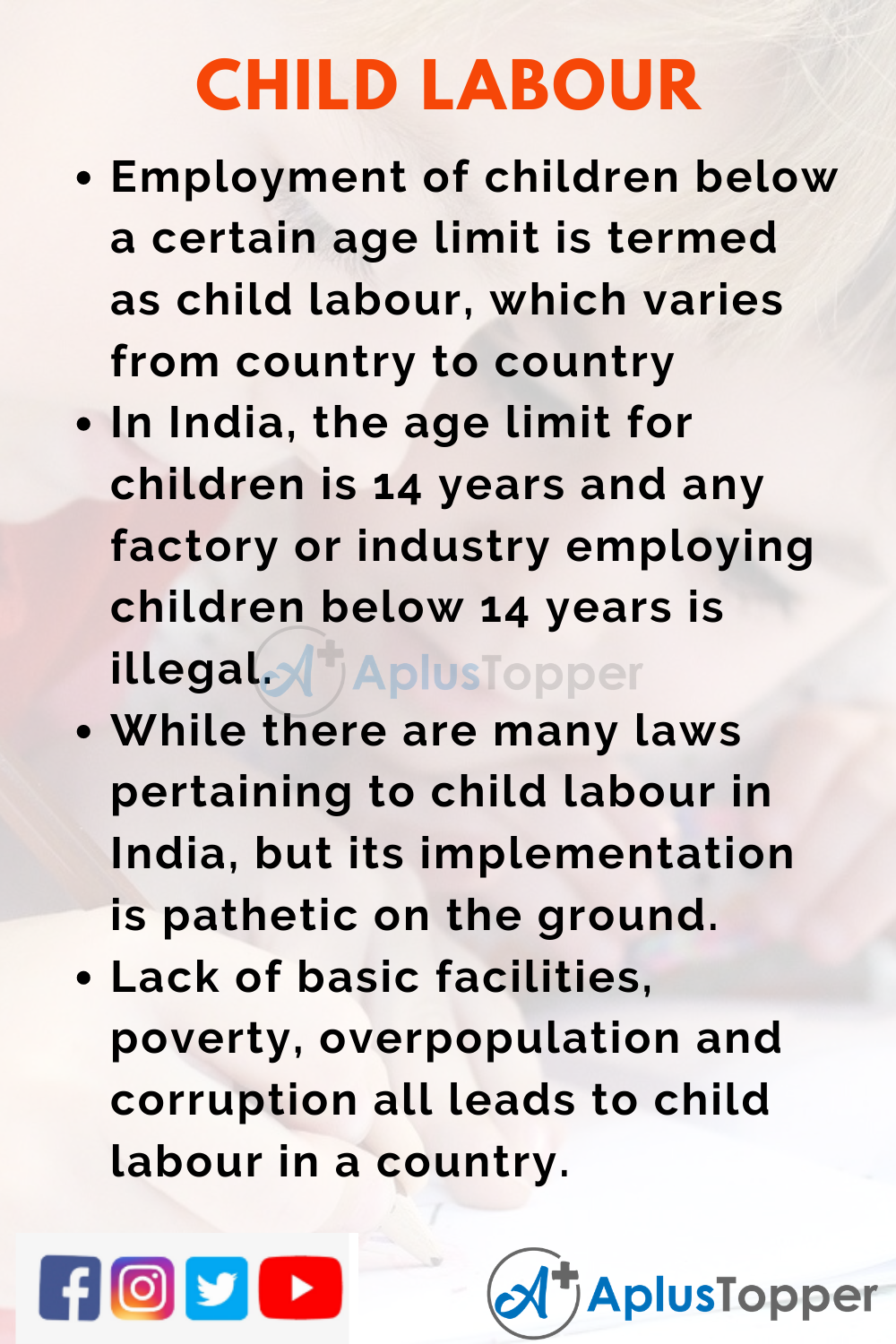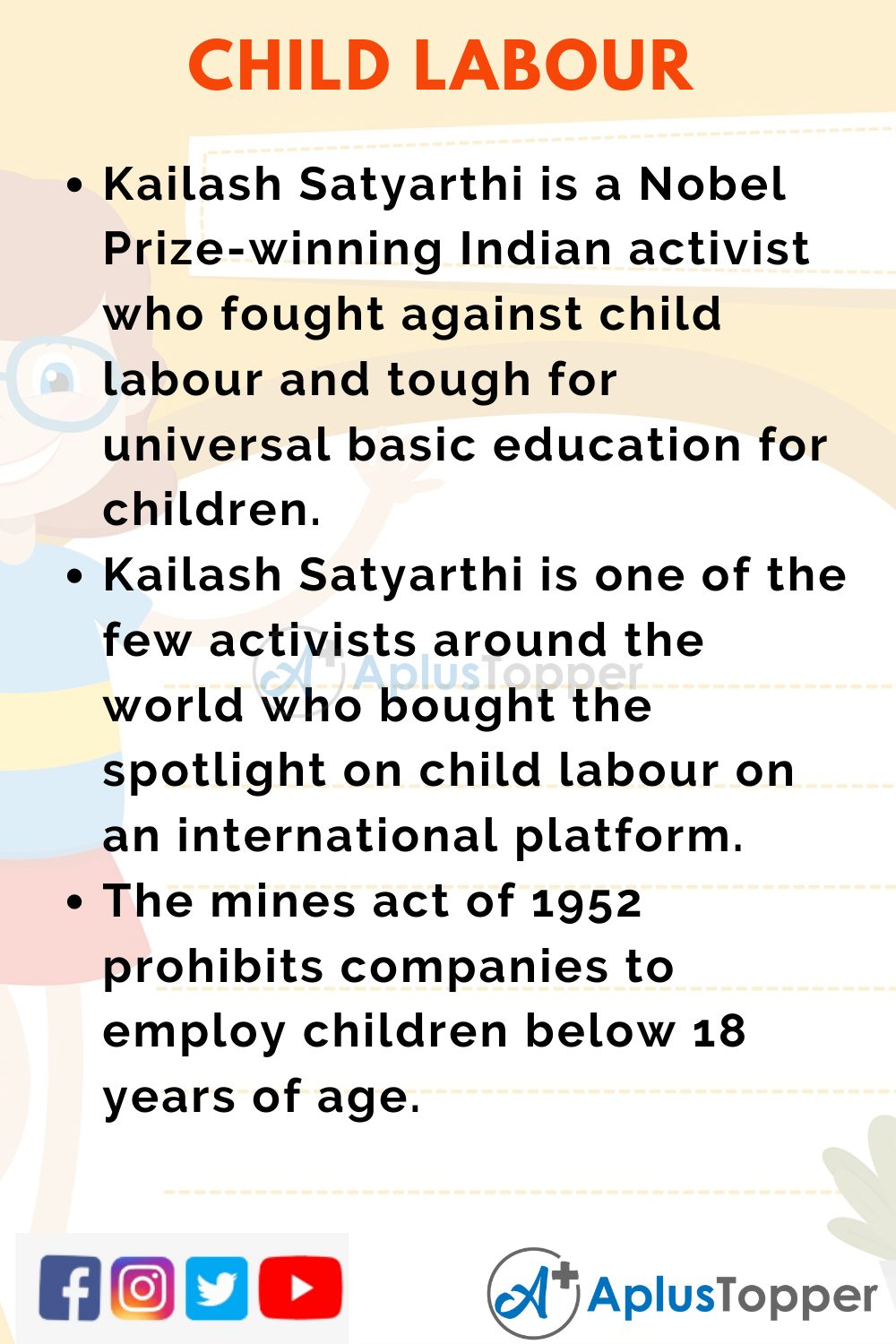10 Lines on Child Labour: We as a society would have failed if we cannot eliminate child labour from the face of the planet. Every country on the planet irrespective of the size of its economy is fighting this dreaded disease of child labour and it is dangerous to even think that the future of our nation is under threat because of child labour.
In this particular article on 10 lines on child labour in English, we shall be addressing various issues and have divided the article into three sets of 10 lines on child labour in English. We shall also be answering few questions such as which country has the most child labour, how to abolish child labour, who is Kailash Satyarthi, what are the laws in India regarding child labour, what is the effect of child labour on our society and many more such questions.
You can read more 10 Lines about articles, events, people, sports, technology many more.
Set 1 – 10 Lines on Child Labour for Kids
Set 1 is helpful for students of Classes 1, 2, 3, 4 and 5.
- Employment of children below a certain age limit is termed as child labour, which varies from country to country
- In India, the age limit for children is 14 years and any factory or industry employing children below 14 years is illegal.
- While there are many laws pertaining to child labour in India, but its implementation is pathetic on the ground.
- Parents tend to send their children to work and earn money instead of getting them educated because of poverty and hunger.
- Lack of basic facilities, poverty, overpopulation and corruption all leads to child labour in a country.
- When a factory employees a child, it is destroying his or her future and taking away the potential of childhood from a child.
- The industry where most child labour work in India is mining and quarrying, construction industry and manufacture of fast fashion clothes.
- Mining activities in Jharkhand, Orissa and northern part of Karnataka employs a lot of child labourers and this flouting of laws openly is criticized by the United Nations
- Factories employ child labour because it is cheaper than employing labourers beyond 18 years of age.
- Children are also employed in the service sector industries such as restaurants and real estates.

Set 2 – 10 Lines on Child Labour for School Children
Set 2 is helpful for students of Classes 6, 7 and 8.
- According to the United Nations International Children’s Fund (UNICEF), child labour is the highest in African nations in comparison with the rest of the world.
- The top states in India for child labour is Uttar Pradesh, Bihar, Rajasthan, Madhya Pradesh and Maharashtra in the descending order.
- More than 10 million children in the age group of 5 to 14 years in India are employed in one factory or another.
- Cheap labour and easy management of kids are the reasons why factories tend to employ children below 14 years of age.
- India is a country where people in rural and backward areas tend to have 5 to 6 children and they send these children to earn money to support the growing needs of the family.
- Lack of proper family planning and awareness in the remote areas of the country is becoming a problem and ultimately leading to child labour.
- Child labour destroys the cognitive and logical thinking abilities of children and leads to physical and mental harassment from a very young age
- Child labour (Prohibition and Regulation) Act 1986 prohibits the employment of children as domestic help or in any factories in any form
- Poverty, illiteracy, lack of family planning and lack of proper basic facilities by the government are the main causes of child labour.
- In poor countries such as Sudan or Republic of Congo, more than 25% of the children in the country’s population are employed as child labourers.
Set 3 – 10 Lines on Child Labour for Higher Class Students
Set 3 is helpful for students of Classes 9, 10, 11, 12 and Competitive Exams.
- Kailash Satyarthi is a Nobel Prize-winning Indian activist who fought against child labour and tough for universal basic education for children.
- Kailash Satyarthi is one of the few activists around the world who bought the spotlight on child labour on an international platform.
- Mining companies in Jharkhand, Orissa and Karnataka employees child labours illegally because of cheap pay and easy management.
- In many rural parts of the country, families tend to have a lot of debt to their landlords and to clear their debt they send children to work which acts as an additional income for the family.
- In spite of making primary and secondary education free of cost around India in government-run schools, parents in certain sections of the population are reluctant to send their children to schools.
- The mines act of 1952 prohibits companies to employ children below 18 years of age.
- Electronic chip manufacturers, fast fashion retail and many other industries directly or indirectly are supporting child labour in third world countries.
- Mining diamond is one of the most horrific phenomena that is taking place in the Republic of Congo and neighbouring countries in Africa where child labourers are hired on a mass scale. The diamonds sold in western markets that have come from African nations are known as “blood diamond”
- Every year thousands of children die in quarries due to mishaps and these reports are usually never reported by the corrupt government officials of the area.
- The right of children to free and compulsory Education Act of 2009 was passed in the Indian Parliament and as a result of this act, 25% of seats in private schools were reserved for children from backward areas and this is known as RTE Act or Right To Education act.

FAQ’s on 10 Lines on Child Labour
Question 1.
How to prevent child labour?
Answer:
Poverty eradication programmes and programs on the importance of education for children should be conducted across backward and remote areas of the country
Question 2.
Why did Kailash satyarthi win the Nobel prize?
Answer:
In the year 2014, Kailash satyarthi won the Nobel Peace Prize for his activism against child labour and his advocacy for universal education in India.
Question 3.
What is Bachpan Bachao Andolan?
Answer:
Bachpan Bachao Andolan is an Indian origin movement for child rights which was started by Nobel Laureate Mr Kailash satyarthi in 1980.
Question 4.
What are the various reasons for child labour across the world?
Answer:
Poverty, debts and corruption in local governments are some of the reasons for child labour in India and around the world
